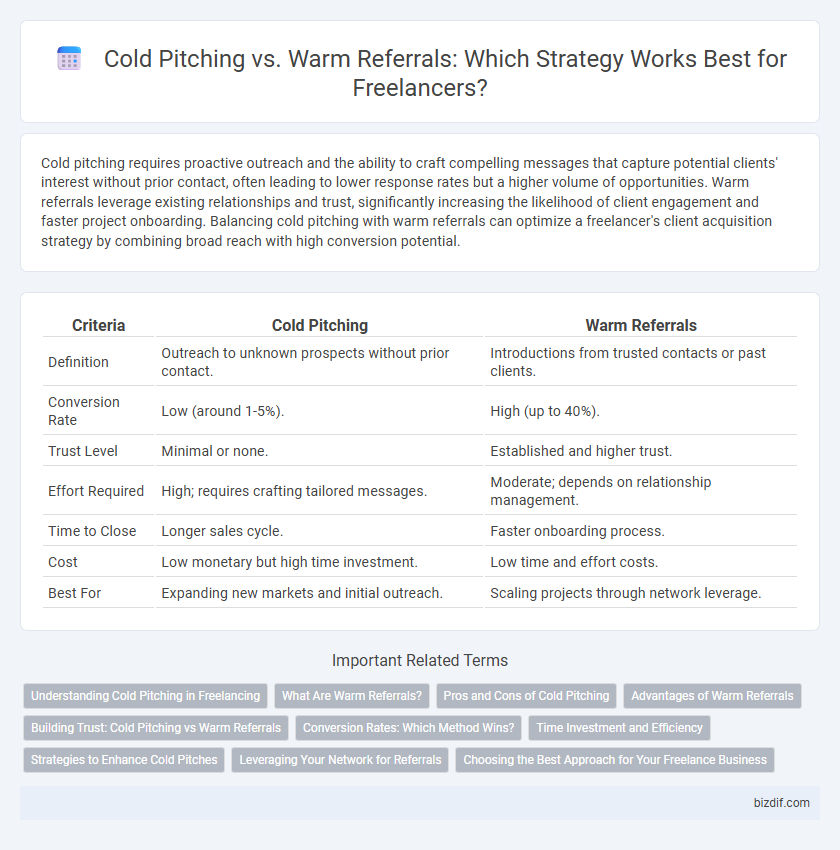Cold pitching requires proactive outreach and the ability to craft compelling messages that capture potential clients' interest without prior contact, often leading to lower response rates but a higher volume of opportunities. Warm referrals leverage existing relationships and trust, significantly increasing the likelihood of client engagement and faster project onboarding. Balancing cold pitching with warm referrals can optimize a freelancer's client acquisition strategy by combining broad reach with high conversion potential.
Table of Comparison
| Criteria | Cold Pitching | Warm Referrals |
|---|---|---|
| Definition | Outreach to unknown prospects without prior contact. | Introductions from trusted contacts or past clients. |
| Conversion Rate | Low (around 1-5%). | High (up to 40%). |
| Trust Level | Minimal or none. | Established and higher trust. |
| Effort Required | High; requires crafting tailored messages. | Moderate; depends on relationship management. |
| Time to Close | Longer sales cycle. | Faster onboarding process. |
| Cost | Low monetary but high time investment. | Low time and effort costs. |
| Best For | Expanding new markets and initial outreach. | Scaling projects through network leverage. |
Understanding Cold Pitching in Freelancing
Cold pitching in freelancing involves reaching out to potential clients without prior contact or introduction, relying on personalized messages that highlight relevant skills and services. This proactive approach demands well-researched proposals tailored to the client's needs, increasing the chances of engagement despite initial unfamiliarity. Mastering cold pitching enhances freelancers' ability to expand their client base beyond existing networks, crucial for consistent project acquisition.
What Are Warm Referrals?
Warm referrals are introductions to potential clients made through mutual connections or previous satisfied clients, which significantly increase trust and credibility in freelancing. Unlike cold pitching, warm referrals leverage existing relationships to provide personalized recommendations, leading to higher response rates and better conversion opportunities. Freelancers benefit from warm referrals by receiving qualified leads and reducing the time spent on marketing efforts.
Pros and Cons of Cold Pitching
Cold pitching allows freelancers to reach a broad range of potential clients without prior connections, expanding opportunities beyond their existing network. However, it often results in lower response rates and requires more time and effort to personalize messages effectively. Success depends heavily on well-crafted communication and persistence despite higher rejection levels compared to warm referrals.
Advantages of Warm Referrals
Warm referrals provide freelancers with higher trust levels and increased chances of securing projects, as recommendations come from established professional relationships. These referrals often lead to faster client onboarding and better communication, reducing the time spent on negotiations and revisions. Warm referrals also enhance a freelancer's credibility and portfolio, making it easier to attract more lucrative projects in competitive markets.
Building Trust: Cold Pitching vs Warm Referrals
Warm referrals generate higher trust levels as they come from known connections who can vouch for a freelancer's skills and reliability, leading to faster client engagement. Cold pitching requires strategic messaging and proof of expertise to overcome the initial trust barrier, often resulting in lower response rates compared to warm referrals. Building trust through warm referrals significantly enhances credibility and increases the chances of securing long-term freelancing projects.
Conversion Rates: Which Method Wins?
Warm referrals consistently yield higher conversion rates than cold pitching, often converting at rates 50% to 70% higher due to established trust and credibility. Clients approached through referrals show greater engagement and willingness to negotiate, significantly reducing sales cycle time. Cold pitching demands more follow-up efforts and offers lower response rates, typically under 10%, making warm referrals the more efficient strategy for freelancers seeking reliable project acquisition.
Time Investment and Efficiency
Cold pitching requires significant time investment in researching prospects and crafting personalized messages, often resulting in lower response rates and longer client acquisition cycles. Warm referrals leverage existing relationships, drastically reducing outreach time and increasing the likelihood of positive responses due to pre-established trust. Freelancers benefit from prioritizing warm referrals to maximize efficiency and minimize the time spent on lead generation.
Strategies to Enhance Cold Pitches
Crafting personalized messages that address the specific needs and pain points of potential clients significantly boosts the success rate of cold pitches. Utilizing targeted research to identify decision-makers and tailoring communication channels, such as LinkedIn or professional email, enhances engagement and response rates. Incorporating social proof like testimonials or case studies in cold outreach establishes credibility and fosters trust, differentiating cold pitches from warm referrals.
Leveraging Your Network for Referrals
Leveraging your network for warm referrals significantly increases your chances of landing freelancing projects by tapping into existing trust and credibility. Warm referrals often lead to higher conversion rates compared to cold pitching, as clients are more likely to engage with freelancers recommended by people they know. Building genuine relationships within your professional network and asking for referrals strategically can create a steady pipeline of quality leads and long-term clients.
Choosing the Best Approach for Your Freelance Business
Cold pitching involves reaching out to potential clients without prior contact, requiring compelling proposals and persistence to convert leads. Warm referrals leverage existing relationships and trust, often resulting in higher response rates and more immediate project opportunities. Selecting the best approach depends on your network strength, industry niche, and the balance between volume of outreach and personalized connections.
Cold Pitching vs Warm Referrals Infographic

 bizdif.com
bizdif.com